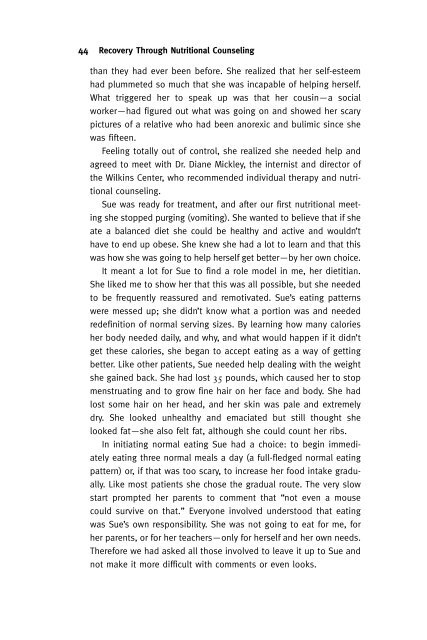Eating Disorders - fieldi
Eating Disorders - fieldi
Eating Disorders - fieldi
You also want an ePaper? Increase the reach of your titles
YUMPU automatically turns print PDFs into web optimized ePapers that Google loves.
44 Recovery Through Nutritional Counseling<br />
than they had ever been before. She realized that her self-esteem<br />
had plummeted so much that she was incapable of helping herself.<br />
What triggered her to speak up was that her cousin—a social<br />
worker—had figured out what was going on and showed her scary<br />
pictures of a relative who had been anorexic and bulimic since she<br />
was fifteen.<br />
Feeling totally out of control, she realized she needed help and<br />
agreed to meet with Dr. Diane Mickley, the internist and director of<br />
the Wilkins Center, who recommended individual therapy and nutritional<br />
counseling.<br />
Sue was ready for treatment, and after our first nutritional meeting<br />
she stopped purging (vomiting). She wanted to believe that if she<br />
ate a balanced diet she could be healthy and active and wouldn’t<br />
have to end up obese. She knew she had a lot to learn and that this<br />
was how she was going to help herself get better—by her own choice.<br />
It meant a lot for Sue to find a role model in me, her dietitian.<br />
She liked me to show her that this was all possible, but she needed<br />
to be frequently reassured and remotivated. Sue’s eating patterns<br />
were messed up; she didn’t know what a portion was and needed<br />
redefinition of normal serving sizes. By learning how many calories<br />
her body needed daily, and why, and what would happen if it didn’t<br />
get these calories, she began to accept eating as a way of getting<br />
better. Like other patients, Sue needed help dealing with the weight<br />
she gained back. She had lost 35 pounds, which caused her to stop<br />
menstruating and to grow fine hair on her face and body. She had<br />
lost some hair on her head, and her skin was pale and extremely<br />
dry. She looked unhealthy and emaciated but still thought she<br />
looked fat—she also felt fat, although she could count her ribs.<br />
In initiating normal eating Sue had a choice: to begin immediately<br />
eating three normal meals a day (a full-fledged normal eating<br />
pattern) or, if that was too scary, to increase her food intake gradually.<br />
Like most patients she chose the gradual route. The very slow<br />
start prompted her parents to comment that “not even a mouse<br />
could survive on that.” Everyone involved understood that eating<br />
was Sue’s own responsibility. She was not going to eat for me, for<br />
her parents, or for her teachers—only for herself and her own needs.<br />
Therefore we had asked all those involved to leave it up to Sue and<br />
not make it more difficult with comments or even looks.









